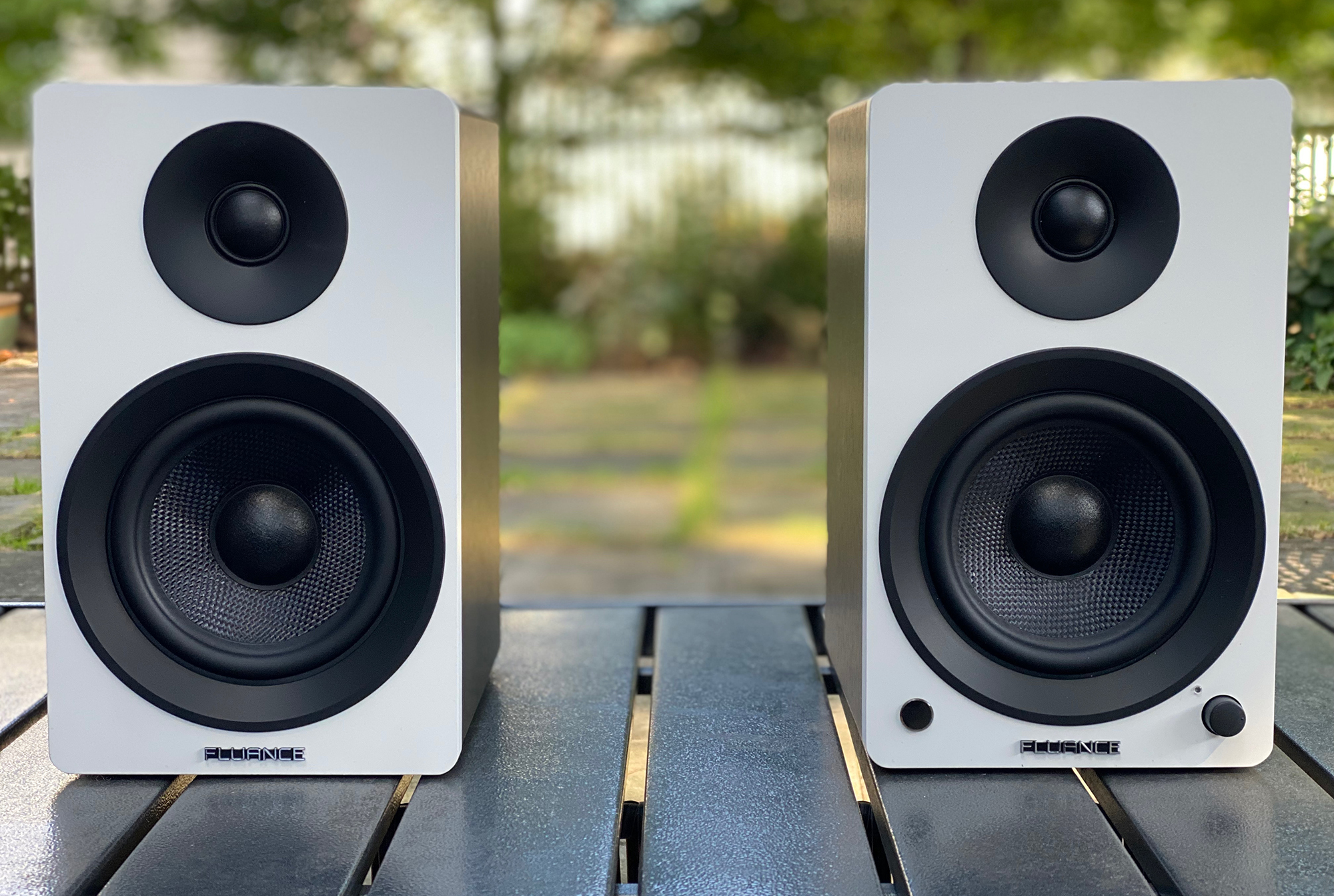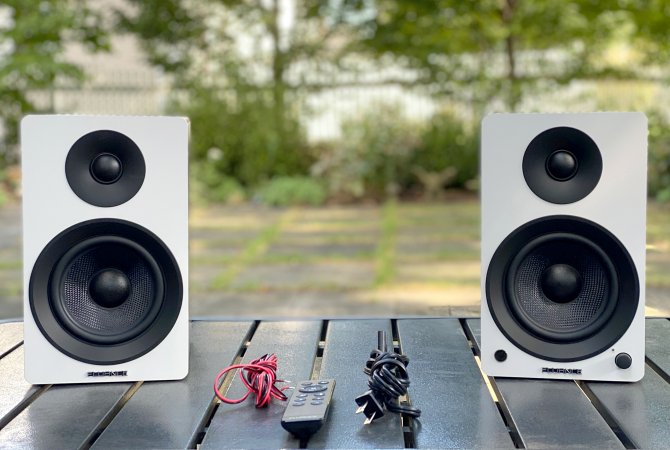

We may earn revenue from the products available on this page and participate in affiliate programs. Learn more ›
With portable Bluetooth party speakers so common nowadays, it’s easy to forget what real left-and-right separation sounds like. We often sacrifice a wide stereo image for convenience. It’s understandable to want a battery-operated, one-driver unit for your camping trip or outdoor patio but why choose to attenuate your experience when in your house? You can still have Bluetooth connectivity and a fair amount of portability with powered bookshelf speakers like the Fluance Ai41 system. Not only do these Fluance speakers give you the joy of a fully deployed soundstage, but they deliver sonic qualities that belie their $249 price tag.
Spread Some Cheer(s)
The design of the Fluance Ai41
A Canadian-based company, Fluance designs hi-fi components with the intention of delivering rich sound without the need to spend a fortune. The Ai41 system (an update to the previous Ai40 model) produces this natural sense of space through a pair of two-way powered speakers, each with dimensions of 10.9 inches (H) by 6.5 inches (W) by 7.6 inches (D). The rear-ported, MDF composite cabinets are small, relatively light, and easy to carry. Each features a 5-inch woven glass fiber composite driver and a 1-inch silk soft-dome neodymium ferrofluid-cooled tweeter.
Fluance equipped the cabinets with rubber feet, which not only prevents them from slipping but helps with decoupling. Without the feet, the cabinets would be resting directly on the surface on which they sit and the vibrations from the speakers could cause that surface to resonate and skew the sound quality.
Especially for users who plan to use the Ai41 in a living room or den, the way the cabinets look is a consideration prior to purchase. The Ai41 comes in several colors: Black Ash, Black Walnut, White Walnut, and White Bamboo. The review speakers that Fluance loaned me were White Bamboo, a color scheme with a light-brown back and sides and a white front. The front looked bright white on the company’s website, but in person was more of a dull off-white. After experiencing them firsthand, I probably would opt for Black Ash or Black Walnut if I were buying a pair.
Setting these home stereo speakers up
In the Fluance Ai41 system, the two speakers have different roles. The 8.52-pound right speaker is active (powered)—containing the internal DAC/Class D amp, a rear panel with connections for external sources, as well as a control knob in the lower right corner of its face. The slightly lighter (7.44-pound) left speaker functions as a passive satellite. One of the advantages of such an arrangement is that you only need to connect the right side to AC power.
The only signal that goes into the left speaker is audio, which comes from the right via an included 8-foot speaker wire with tinned ends. If you need more length, you can substitute your own cable—Fluance recommends 18-gauge wire like the included cable. Other accessories in the box include a remote control and a pair of AA batteries for it (more on the remote in a bit).
The Fluance Ai41 supports three different types of connections: Bluetooth (5.0+BR+EDR+BLE), optical (TOSLINK), and analog (via RCA jacks). An RCA output on the right speaker cuts out all the bass below 80Hz from the speakers when you connect it to a dedicated sub. If you want to use the Ai41 for vinyl, however, you’ll need to add an external phono preamp to take advantage of a turntable—a natural pairing with the excellent Fluance RT85, for instance—or to search out a deck with a built-in preamp.

Find your happy place(ment)
When placing the Fluance Ai41 cabinets, follow the standard guidelines for bookshelf speakers. Situate them at about 10 and 2 o’clock when viewed from your listening position, with the tweeters as close to ear level as possible. Leave as much space between the speakers and the wall behind them as is practical for a couple of reasons: First, you don’t want to block the rear ports. They’re part of the acoustic design and blocking them will change the performance of the cabinet. Second, placement too close to a wall can cause a bass buildup.
When I first set the Ai41s up, I placed the speakers on a workstation table and connected the speaker wires to their binding posts from above. For the active speaker, it was easy. I loosened the five-way gold-plated post covers, dropped the cable ends through the appropriate holes, and tightened the covers. However, the left side requires a little more work because its posts are angled up at about 45-degrees. There wasn’t room to place the speaker cables down through the binding-post holes. Instead, I had to turn the cabinet upside down to thread the wires through before tightening.
Right on cue
To power on the Fluance Ai41s, you first flip the power switch on the back of the right speaker to its On position. Then you’ll see that speaker’s front-panel LED glowing red, which indicates that the system is in Standby mode. From there, pressing the control knob once changes the light to green, which is for RCA input. Another press and it turns blue, which is for Bluetooth. One more press turns it white, which activates the Optical input.
Pairing with a Bluetooth device is easy. Just put the active speaker into Bluetooth mode and it immediately searches for any devices in range. Like almost any modern Bluetooth device, it showed up in my phone’s Bluetooth settings panel and paired right away. When pairing is successful, the speaker plays an indicator sound consisting of low-to-high tom-tom hits. If you turn off the connected device or unpair it, the speaker plays a high-to-low version. If you have any trouble pairing, the right speaker also includes a Bluetooth Reset button.
You can adjust the volume and change sources or go back to Standby mode with the control knob. If you use the remote control, you get some helpful additional functions. It lets you skip backward and forward by track, mute the system and adjust the equalization.
The Butterworth crossover for EQ, accessible through the remote control, consists of treble and bass bands, each with plus and minus buttons that let you boost or cut by up to 5dB. The manufacturer doesn’t specify any more detail about the filter, bandwidth, or corner frequency.
I found adjusting the EQ precisely to be a little tricky. The LED on the right speaker gives you flashing indicators when you’ve reached either of the adjustment limits (+5dB or -5dB) or the midpoint (0dB). The hard part is if you want a setting that’s in between flat and one of the extremes. There are no indicators to tell you where in that area you’ve set it.
Rather than holding down the Treble or Bass button while adjusting, which moved through the range of the control too quickly, I found it best to press and release in short, even intervals. Probably the best solution is just to use your ears when making the settings. The system retains your EQ settings when you power down.
What do these Fluance speakers sound like?
I tried the Fluance Ai41 system in several locations in my house, including a tabletop, on a workstation table, on small isoAcoustics speaker stands, and on a bookshelf in a media room. I tried both the Bluetooth and RCA modes and didn’t notice any substantial sonic differences between analog or digital playback.
In all locations, I was impressed with the expressive frequency range—a DSP-enhanced 35Hz-20kHz. Listening to the deadmau5 track “4Ware,” I could feel the thump of the kick drum more than I’d expect from 5-inch drivers. I also listened to Donald Fagen’s “New Frontier,” which has pristine production values, and found the clarity and balance of the speakers to be quite good.
A jazz track such as “Days of Wine and Roses” by Oscar Peterson showed off the full range of the Ai41s. The upright bass was not only fat on the bottom, but also you could hear its midrange and upper-mid details as well. Cymbals were crisp, as were the high-notes on the piano, and other high-end heavy sources were bright without being harsh. The overall output was accurate while enthusiastic, smooth without being overly polished.
I also put on “Round Rock,” from Béla Fleck’s new album “My Bluegrass Heart,” and the banjo, acoustic guitar, Dobro, upright bass, mandolin, and fiddle sounded clean and natural. Listening to the “chop” of the mandolin reinforced to me how good the transient response of these speakers is.
The amplifier built into the right-side speaker sends 90W of continuous average output—45W RMS per side. For relatively small powered speakers, they got pretty loud without distorting.

So, who should buy the Fluance Ai41s?
After using the Fluance Ai41 system for a couple of weeks, I am definitely impressed. A general music lover looking for compact Bluetooth stereo speakers to use in a dorm room, bedroom, kitchen, or relatively small den or media room will not be disappointed. They’d also provide a sonic upgrade from many computer and TV speakers. You could connect with RCA cables and still have the option to play music via Bluetooth, while the ability to port in audio from a wired source provides a nice option for higher-fidelity formats and somewhat more critical listening.
If you want more volume and options, you might consider the next model up, the Ai61. Slightly larger than the Ai41, it offers 6.5-inch woofers and 120W of total power. I haven’t had a chance to hear what it sounds like but, based on the specs, it provides an even wider frequency range, particularly on the bottom end, and louder playback without distortion. However, the Ai61 pair costs $100 more.
To me, the Ai41s offer a better value. These Fluance speakers provide a wide, well-anchored sound, good connectivity options, and plenty of power. You could easily spend hundreds, even thousands more on the best bookshelf speakers, but if you’re choosing between affordable stereo speakers like the Ai41s and an easily movable but mono Bluetooth speaker for indoor use, I’d go with the far more enveloping Fluance Ai41 system. Sure, you’d sacrifice some actual portability but you’ll be emotionally transported by the sound quality.

